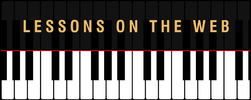 When is the last time you said something that you felt really strongly about?
There are lots of times that we speak to others with passion and emotional emphasis because it gets our point across. The more important the message is for us to convey - the more emotion we use when we verbally speak our thoughts. If we speak the words with no emotion, we usually get no reaction at all or at least not the reaction that we're looking for. Most times, we're looking for a reaction that mirrors our own emotional feelings at that moment. Imagine saying "the house is on fire" with no emotions at all...who's going to take you seriously?! If, however, you say "the HOUSE is on FIRE!"...people will believe you and react appropriately. They'll run! In music and in our piano playing we all these emotionally fueled types of communication dynamics. When we first look at a piece of music it's usually the notes that we see and focus on. And it's the notes that we learn first along with the correct key signature, (sharps and flats) and the correct rhythms. Once we spend some time practicing on these things, we can pretty well play through the whole piece without many mistakes and without stopping. This is when we get the bigger picture of what the "message" or the story is that the composer is trying to get across to the performer and most of all, the listener(s). The notes themselves always give us an indication of the emotional make-up of a piece. The Key Signature does this as well in terms of whether we're in a Major or Minor Key. But then we have to look at what they dynamic markings are in the piece and include them as we play through it. If we play through the piece with no emotional backing to the notes, meaning we don't use any dynamics, it's going to sound boring and it won't express the true intent of the composer. You see, dynamics bring a certain "life" to the notes that take them from being rather empty to having a fullness of sound that induces an emotional reaction to the music. Music is the language of emotions. That's why we have to "speak" it with emotions and not just with our intellect. Once you play a passage in your piece with soft and loud notes, you'll hear something completely new and different. And you'll feel it as well; because the different levels of volume that we play in relate directly to the amount of emotion we're feeling and even the type of emotion we're feeling. More, we want the listeners to feel that same emotion and to react to it. Dynamics allow the music to make sense not just intellectually but also emotionally and connect us and the listeners to the music in a much deeper way. Notice in your music all of the dynamic markings from the beginning. This way you'll be able to start learning and practicing them along with your notes and you won't have to come back and do it later. Here's a basic chart of the different dynamic markings you'll find in your music. If you need a review of HOW to play dynamics in your playing, be sure to check out this article to get you started! Stay Tuned to PianoLessonsOnTheWeb.com to learn much more and achieve your dream of playing the piano! |
AuthorMost blogs written by Archives
June 2020
Categories
All
|


 RSS Feed
RSS Feed